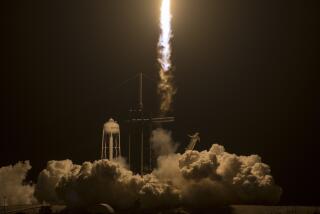Navy Reports Design Flaw in Trident 2
- Share via
WASHINGTON — The Navy has discovered a design flaw that causes new Trident 2 missiles to explode seconds after launch when they are fired from submerged submarines, officials said today.
They added that the flaw can be corrected.
Navy spokesman Lt. Greg Smith said the Navy believes that Trident 2 missiles blew up in tests in March and again Tuesday because the design cannot withstand the water pressure on the missiles as they rocket up through the ocean.
He said the Navy is confident that this problem will be solved.
Lockheed Corp., the major contractor for the missile, said its policy is to leave comment on the Trident 2 to the Navy.
A third Trident 2 submerged firing test earlier this month was successful, and Smith said the Navy still expects the missiles to be deployed on submarines beginning in March.
The powerful new missile is intended to be a centerpiece of U.S. long-range nuclear missile forces, carrying up to eight nuclear warheads and steering them so accurately that they can destroy Soviet missiles still in silos.
The Navy said the Trident 2, in the first undersea test, cartwheeled spectacularly in the air and blew up because launch pressure had jammed a steering nozzle on the bottom in the wrong position.
It said a nozzle also appeared to be in the wrong position in the failure Tuesday. But beyond that, it said, electrical cables snapped and triggered the self-destruct procedure that blew up the missile eight seconds after launch, four seconds after the missile broke out of the ocean.
Smith said the Navy believes that both failures were caused by greater than expected pressure from the plume of water that is drawn up under the missile as it shoots through between 30 and 40 feet of water before igniting just above the ocean’s surface.
More to Read
Sign up for Essential California
The most important California stories and recommendations in your inbox every morning.
You may occasionally receive promotional content from the Los Angeles Times.













